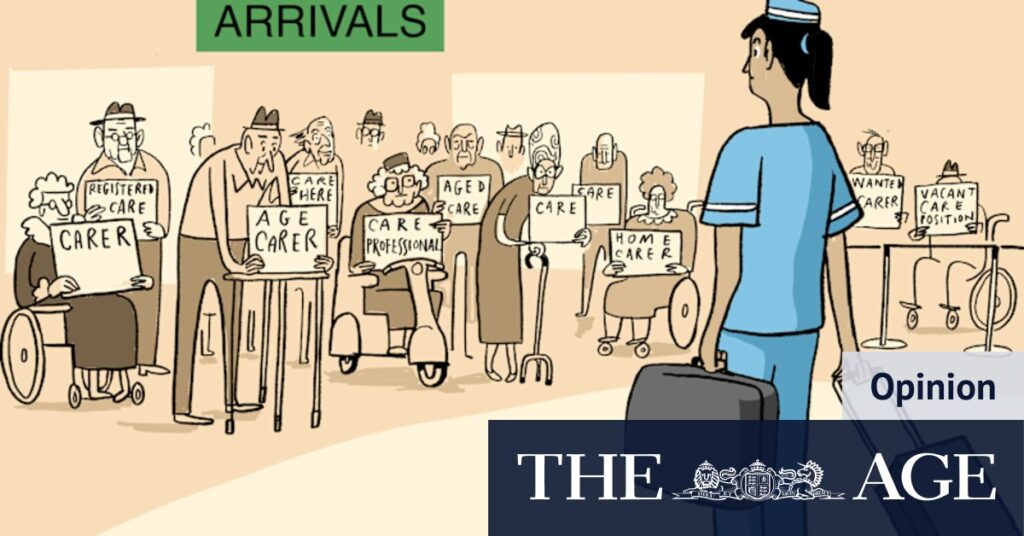
If you or a loved one requires aged care services in Australia, you are likely experiencing a time of significant uncertainty. The aged care system, already complex to navigate, is on the brink of substantial reforms set to commence next month. These changes aim to overhaul how older Australians pay for their care, with the ultimate goal of creating a sustainable framework that allows more individuals to age comfortably in their own homes.
Despite the understandable concerns surrounding the new system’s implementation, one thing is clear: the demand for aged care cannot be met without a considerable increase in the workforce. This pressing issue was highlighted in a recent Senate inquiry report, which urges a transition to a demand-driven system, echoing recommendations from the aged care royal commission.
Workforce Shortages Threaten Aged Care Reforms
The proposed shift towards a demand-driven model faces a significant obstacle: a chronic shortage of aged care workers in Australia. A 2021 analysis revealed that the country would need at least 400,000 additional workers in both residential and in-home aged care by 2050. Unfortunately, there is little indication that this trajectory is changing.
The community’s desire for more and higher-quality care for older Australians is evident. Most individuals prefer to age in their own homes rather than in residential facilities. However, fulfilling this expectation requires a substantial expansion of the workforce. As the population ages, the demand for care and carers will continue to rise. It is estimated that by 2050, approximately 2.5 million Australians aged 65 and over will require some form of care, up from the current 1.5 million.
Immigration as a Solution to Workforce Gaps
To address this workforce shortage, experts suggest that the federal government should introduce a new visa specifically for aged care workers. Currently, the most severely impacted aged care occupations do not qualify for other skilled migration visas due to their annual salaries falling below the minimum threshold of approximately $76,000.
As a result, the government has been relying on labor agreements to fill the gap, intended to facilitate the entry of qualified overseas workers. However, by the end of June, only about 2,400 temporary migrants were sponsored under these agreements in the sector, representing less than 4% of the temporary migrants in these occupations in Australia. Furthermore, this figure accounts for less than 1% of all personal care workers in aged care.
“While we welcome anyone motivated to work in aged care, we need to focus on bringing in qualified, experienced workers who are job-ready.”
Most temporary migrants working in aged care arrived on student, partner, or working holiday visas. While these individuals are welcomed, there is a pressing need for qualified workers who can enhance the quality of care and provide better training for new entrants.
Challenges and Proposed Solutions
Aged care has historically relied heavily on migrant workers, with estimates suggesting around 70,000 – or one in six – personal care workers are on temporary visas. This is a conservative estimate, and where genuine shortages exist, as in aged care, the system should facilitate more streamlined and targeted migration.
The government’s Migration Strategy acknowledged this issue, committing to explore an essential skills visa pathway for lower-wage migrant workers in sectors like aged care that face chronic shortages. However, progress has been slow, with aged care providers using existing agreements to retain staff rather than expand their workforce due to lengthy negotiations, varying state processes, and high visa costs.
“An essential skills visa would provide a direct, streamlined process available to all aged care providers, eliminating complex negotiations and state-by-state inconsistencies.”
The proposed essential skills visa aims to increase not only the number of workers but also their skill and experience levels. Providers would access a pool of qualified migrants through an online matching system, ensuring relevant experience, appropriate qualifications, and English proficiency. Fast-tracked processing would meet the immediate need, allowing workers genuine mobility within the sector.
Looking Forward: A Multifaceted Approach
Critically, labor market testing should be abolished for these occupations. The chronic shortage of Australian workers in aged care makes the requirement for employers to advertise positions for four weeks before sponsoring a migrant unnecessary. Regular evaluations every three to five years would ensure the visa’s effectiveness without suppressing wages or discouraging local worker training.
This approach does not prioritize migration over Australian workers. It is essential to continue growing the pipeline of Australian aged care workers through improved pay, conditions, and training. Recent wage increases have helped retain existing staff but have not attracted new workers.
Ultimately, there are not enough Australians available to meet the demand for aged care work. A comprehensive strategy involving training more Australians, improving conditions, leveraging new technology, and embracing migration is necessary. Given the magnitude of the challenge, no single solution will suffice. Delays will only result in more older Australians missing out on the care they need.





